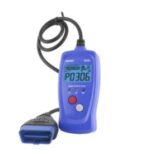Experiencing engine performance issues with your 1997 Ford Escort? You might be encountering the OBDII code P1131, which signals a “Lack of HO2S11 Switch – Sensor Indicates Lean Condition.” This code indicates that the upstream oxygen sensor (O2 sensor), specifically Sensor 1 in Bank 1, is detecting a lean air-fuel mixture in your engine’s exhaust. Understanding the causes, symptoms, and solutions for this code is crucial to restoring your Ford Escort’s performance and fuel efficiency.
Understanding OBDII Code P1131 on a 1997 Ford Escort
The P1131 code is triggered when your Ford Escort’s Powertrain Control Module (PCM) detects that the upstream O2 sensor is reporting a consistently lean condition. This means the sensor is indicating that there is too much oxygen and not enough fuel in the exhaust gases. While a lean mixture might sound fuel-efficient, it can lead to various performance problems and potentially damage your engine over time.
This issue often manifests itself particularly in colder weather conditions. As experienced by many Ford Escort owners, the symptoms might become noticeable within the first 5 to 15 minutes after starting the car, especially when the engine is under slight load, such as driving uphill or on highway ramps. The problem may present as a temporary loss of power, which can resolve itself within a short period, sometimes around 30 seconds.
Symptoms of a P1131 Code in a 1997 Ford Escort
Recognizing the symptoms associated with a P1131 code can help you diagnose the issue quickly. Common symptoms include:
- Check Engine Light: The most obvious sign is the illumination of your “Check Engine” or “Service Engine Soon” light on the dashboard.
- Loss of Power: You might experience a noticeable decrease in engine power, particularly during acceleration or when driving uphill. This is often more pronounced in colder temperatures.
- Rough Idling: In some cases, a lean condition can cause the engine to idle roughly or unevenly.
- Poor Fuel Economy: Although a lean condition might seem fuel-efficient, in reality, it can lead to inefficient combustion and ultimately decrease your fuel mileage.
- Hesitation or Stumbling: The engine might hesitate or stumble upon acceleration.
Potential Causes of P1131 Code
Several factors can contribute to a P1131 code in a 1997 Ford Escort. Pinpointing the exact cause is essential for effective repair. Common causes include:
- Faulty Upstream O2 Sensor (Bank 1, Sensor 1): The most frequent culprit is a failing or degraded upstream O2 sensor. Over time, these sensors can wear out and become less accurate in reading the air-fuel mixture. As mentioned in personal experiences, residue from intake manifold cleaning chemicals can also prematurely foul the sensor.
- Vacuum Leaks: Vacuum leaks allow unmetered air to enter the intake manifold, leading to a lean mixture. Check for leaks in vacuum hoses, intake gaskets, and around the intake manifold.
- Intake Manifold Issues: As highlighted in the original experience, improper cleaning of the intake manifold after procedures like valve seat replacement can leave chemical residue. These residues can off-gas and contaminate the O2 sensor, causing it to report a lean condition.
- Fuel System Problems: Low fuel pressure, a clogged fuel filter, or failing fuel injectors can restrict fuel delivery, resulting in a lean mixture.
- Exhaust Leaks: Exhaust leaks near the upstream O2 sensor can introduce extra oxygen into the exhaust stream, falsely indicating a lean condition to the sensor.
Diagnosing and Repairing P1131 Code
Diagnosing a P1131 code typically involves the following steps:
- OBDII Scanner Check: Use an OBDII scanner to confirm the presence of the P1131 code and check for any other related codes.
- Inspect the Upstream O2 Sensor: Visually inspect the upstream O2 sensor and its wiring for any damage or corrosion.
- Check for Vacuum Leaks: Use a vacuum gauge or propane torch (carefully) to check for vacuum leaks around hoses and intake manifold areas.
- Fuel System Inspection: Check fuel pressure and consider inspecting the fuel filter and injectors.
- O2 Sensor Replacement: If other causes are ruled out, replacing the upstream O2 sensor is often the most effective solution, especially on an older vehicle like a 1997 Ford Escort.
Resolving Power Loss and Cold Weather Issues
As described in personal accounts, the power loss associated with P1131, particularly in cold weather, is often linked to the ECU’s (Engine Control Unit) fuel mixture calculations. When the ECU detects a lean condition and enters open loop mode, it relies on default fuel tables. These tables assume a standard intake air temperature. In colder temperatures, denser air leads to a leaner mixture than the ECU anticipates, causing temporary power loss, especially under load.
Replacing the faulty upstream O2 sensor can directly address this issue by allowing the ECU to accurately monitor the air-fuel mixture and adjust fuel delivery accordingly, even in varying temperatures.
Conclusion
OBDII code P1131 on a 1997 Ford Escort points to a lean fuel mixture condition, often related to a failing upstream O2 sensor. By understanding the symptoms, potential causes, and diagnostic steps, you can effectively troubleshoot and resolve this issue. Replacing the O2 sensor is frequently the solution, restoring your vehicle’s performance and fuel efficiency. Remember to address this code promptly to prevent potential engine damage and maintain the optimal operation of your Ford Escort.

